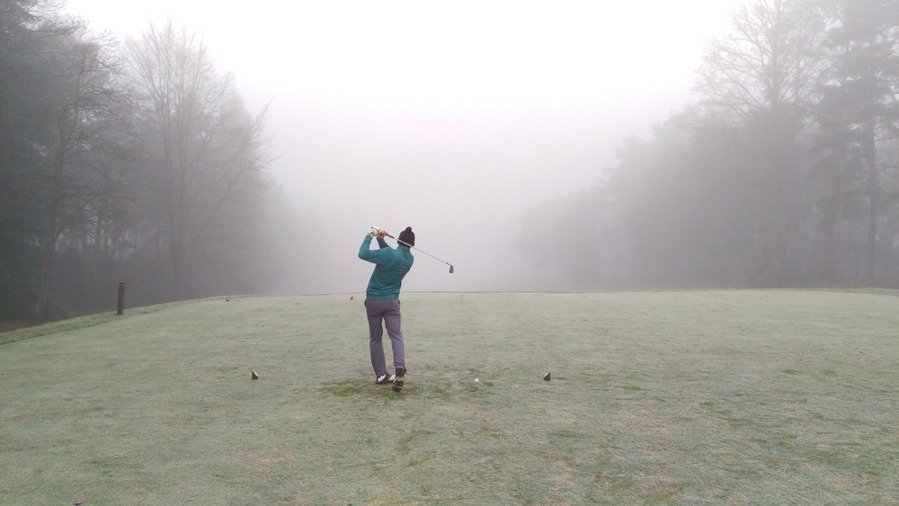In this blog we are going to talk about all aspects of playing winter golf, and enjoying it.
Many people don’t enjoy winter golf and some don’t even play at all in the winter in the UK even though the courses are open.
It can often be wet & muddy under foot and obviously frost plays a big part in determining how ‘playable’ a course is and if you are on temporary tees &/or greens.
It is easy to get caught out in winter with the unpredictable British weather where the temperature from one day to the next can fluctuate 10C or more. One day it can be 13C and quite pleasant and the next day it is 3C with a nasty wind chill probably pushing down towards freezing.
Due to the nice weather previously and still having your bag kitted out for summer play it is easy to not have a bobble hat, mittens, or anything else & freeze half to death! Hence a blog on winter golf &, how to get the most out of it, will hopefully be useful.
First point to mention is be prepared, the bit failed at as mentioned above. If you remove waterproofs, umbrella & winter clothing from your bag in the summer months to save weight you need to be clever about when you put this stuff back in the bag. No matter who you are you are not going to play as good a golf as your capable of if your cold and wet. Take a good long look at the weather forecast a few days before playing and keep monitoring it. If you’re not sure make sure all this kit is back in the bag by mid-November at the latest.
At 5C or less it is important you think about keeping your hands & head warm. If you particularly feel the cold, make sure you get those underlayers (thermals) on especially on your bottom half and a good thick pair of golf socks. These socks are just that bit thicker than normal socks and go a long way to keeping you warm on the course.
Mittens you can wear when not hitting are good to keep wind chill off your bare skin but the tear off hand warmers are best, one in each pocket, to keep your hands toasty between shots. These are sold in most pro-shops but you can bulk buy a box of 50 pairs on the internet for a good price which will last you all winter. Trying to putt or rip a drive with cold, unfeeling, hands is neigh no impossible.
Shoes are worth a thought aswell. With the style & fashion in recent years leaning towards trainer style golf shoes these shoes are incredibly comfortable but are not always the most waterproof or best material to keep you warm. If budget allows a ‘winter’ pair of shoes that are a bit bulkier & fully waterproof can save much discomfort out on the course. If not think about this factor when choosing your golf shoes to make sure they apply in all weather conditions.
When golf gloves get wet they never seem to fully go back to normal when dried. For this reason, keeping a few of your old gloves in the bag and rotating them during a wet round is a great idea and will keep your hands as warm as possible whilst also keeping your ‘best’ glove completely dry and perfect for the next dry round you have.
Some of the glove manufacturers make a ‘winter’ or ‘all weather’ glove which are made from a fabric material rather than a leather and these are worth a try but if you like to chip and putt without a glove or you like to remove your glove between shots this may prove to not be the best option for you.
Changing the colour of your ball can help spot it when in the rough or leaves have fallen and the course is a bit muddy with a yellow ball being the most obvious choice but other colours are available.
This can sound extravagant but having a winter bag can work really well as if you have a really expensive cart bag these can fade and look tired very quickly if they are getting wet and mud splatted every week during the winter & so if you buy a cheaper but fully waterproof bag for winter months your expensive cart bag will still look in great condition for much longer.
Also buying a winter bag that has the option to carry (with stands) is great aswell as many courses will not allow you to take a buggy on the course and some won’t allow trolleys ether if it is particularly wet and muddy. Walking is one of the added bonuses of our sport and unless you have a legit medical reason why you can’t walk I encourage all golfers to walk as this low impact exercise has many benefits both now and in the future.
If you carry your bag you burn upto 500 calories more than if you used an electric trolley which in winter can be good as you may want to use this as a bit of extra training to be fitter & ready for when the summer golf season starts.
In winter the course management will restrict the areas trolleys and buggies can go to protect the course so another bonus of carrying is the bag is on your back and so you can get to your ball almost every time with your equipment close at hand.
Lots of golfers in the winter, especially if they are carrying, will reduce the number of clubs they carry in the bag from the maximum 14 to perhaps 10 or so. This saves weight but also carry bags tend to have less compartments and so they get stuck when removing or replacing. Perhaps a wedge, a long iron and a wood could be removed without you feeling you have lost anything from your arsenal.
Once you have decided on your kit & are ready for changeable conditions & you’re wearing the right number of layers to not let the cold become a negative factor in your game then you have done all within your power to play your best.
Another big point about winter golf is to manage your expectations from the get go. Winter golf is not an ideal time to start expecting personal best rounds and cutting lots of shots off your handicap. It’s not impossible of course it’s just harder so be honest with what your realistically going to achieve bearing in mind the weather conditions.
Try to play to handicap, 36 points if you’re playing stableford. Trying to do something amazing when its wet, muddy and 3C will lead to you trying to hit it harder, playing worse, and getting frustrated. If your expectation is to just go out, enjoy your game & be a bit smarter with how I play that’s a much better way to enjoy winter golf.
Winter golf is more about staying sharp and keeping your eye in over the winter period so you hit the ground running for the next season. It’s an opportunity to continue playing, perhaps work on some new swing thoughts into your sub-conscious so it is muscle memorised ready for the new season.
Temporary greens are done for a reason, usually to protect frozen roots below the surface. People walking on or if an approaching ball will damage a water logged green it may also be shut for use until conditions improve.
It can really depend how well your club presents temporary greens as to whether it is fine to play on or can spoil the round to a certain degree if its bobbly, muddy and impossible to putt on. If these are in force at your course don’t let it ruin the round just use it as a practice round to work on your long game. A good idea is to agree with your playing partners to allow a ‘gimme’ from inside a putter’s length when on temp greens.
Check its preferred lies before you play and make sure you take advantage of this rule. So many amateurs don’t take advantage of this & make the game harder than it needs to be. Most the time preferred lies will apply to any area of ‘closely-mown’ grass fairway length or less. You are allowed to mark, lift, clean and place the ball back in an area no closer to the hole specified by the committee (typically within 6 inches of the original spot).
This makes getting off the tee and hitting fairways really important as you are guaranteeing a good lie from the fairway as oppose to further up the hole but in the rough. Perhaps playing a wood, hybrid or long iron off the tee to guarantee a fairway hit is something worth considering when playing in preferred lies conditions?
The ball does not roll anywhere near as far in the winter, if at all, compared to summer. Therefore, winter golf is all about carry distance. For this reason, most amateurs come up short due to not knowing or considering their carry distances. You can hit a perfect drive straight down the middle that carries 210 yards and basically plugs in the fairway with 0 yards roll. You may feel you have hit a bad shot as you are used to 250 off the tee but this may be with 30-40 yards of roll on a nice dry fairway. This comes back to the point earlier about managing expectations and understanding your performance relative to the conditions.
As a general rule take at least an extra club to start with and then see how you get on. Don’t hit the club you always hit as you can quickly become frustrated with your score compared to normal. A gapping session on a launch monitor looking purely at carry would be a great exercise to do with a local PGA pro or facility.
When putting the greens will tend to be slower with less break in the winter compared to summer. It’s very easy to over read and under hit a putt in the winter. Being aware of this and being reactive from the feedback of your first few putts is key to adapting and having a good round putting wise. Most greens will be very soft because they are so wet & you can see this by making small footprints in the grass as you walk across the green. Try not to stand on yours or your playing partners lines and again use the rules to your advantage. Mark, clean and replace the ball every time and remove loose impediments that are on your line to give yourself the best chance.
In conclusion lets be thankful we are able to play all year round, many of our amateur golfing friends can’t due to snow or other extreme conditions so let’s try to make the most of it, manage expectations & enjoy it.
Thanks for reading, I hope this Blog has been helpful.
There are lots of other blogs and content on the Golf Geeks Website aimed at helping fellow amateur golfers aswell as a large selection of quality assured second hand golf clubs to suit all budgets.
Matt @ Golf Geeks








 Brian Bamford
Brian Bamford




